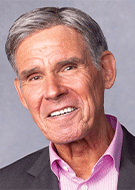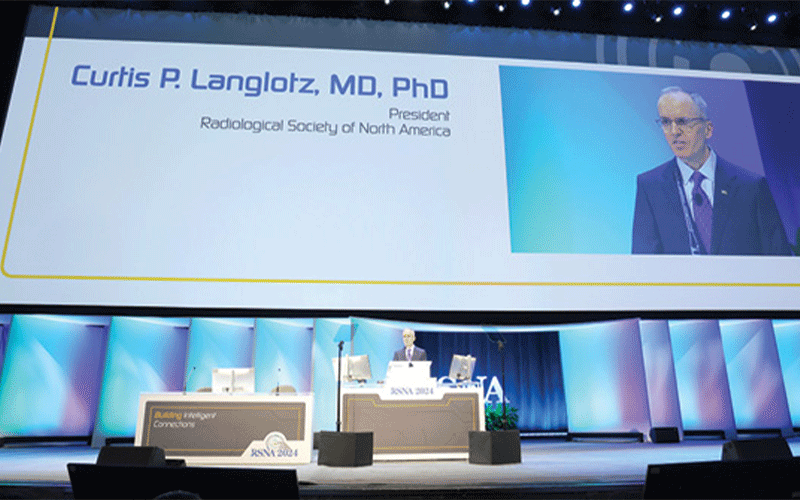The Future of Radiology: AI's Transformative Role in Medical Imaging
AI is paving the way to a reimagined relationship between technology and human expertise



At RSNA 2024, plenary session speakers highlighted the opportunities and challenges AI brings to radiology, underlining its potential to revolutionize health care delivery and improve patient outcomes.
In his opening address, RSNA 2024 President Curtis P. Langlotz, MD, PhD, explored the transformative role of AI in radiology, emphasizing its ability to forge connections between machines and humans.
“Forming intelligent connections from machine to machine, human to machine, and human to human will lead us to an exciting future,” Dr. Langlotz remarked. “These intelligent connections will yield amazing technological innovations, with reduced stress, a more balanced life, and ample time to nurture the mostintelligent connections of all: the ones we build with each other.”
Dr. Langlotz credited radiology’s historical success to its early embrace of new technologies, from X-rays to MRI, and now to AI systems. While he acknowledged initial anxieties surrounding AI’s role in medical imaging, he noted that these concerns have largely subsided as radiologists gain experience with AI tools.
“Anyone who works with AI knows that machine intelligence is different, not better than human intelligence,” he said.
To maximize AI’s potential, Dr. Langlotz proposed several steps, starting with improving data accessibility and diversity. He advocated for universal electronic image exchange and suggested allowing patients to donate their de-identified data for research and AI training. He also emphasized designing fair and representative AI models through diverse interdisciplinary teams and creating systems that explain their reasoning transparently.

Augmenting Human Intellect
Echoing Dr. Langlotz’s optimism, Nina Kottler, MD, MS, associate chief medical officer for clinical AI at Radiology Partners in El Segundo, CA, discussed AI’s role in managing the massive influx of data into radiology— from molecular imaging to genomics and wearable devices.
“Our current processes and technologies just aren’t serving us,” Dr. Kottler said. “There’s a massive amount of information coming into the system, and our turnaround times are increasing.”
Dr. Kottler stressed the importance of radiologists taking the lead in developing AI tools tailored to their workflows.
“The goal is an expert radiologist partnering with a transparent and explainable AI system,” she said. “Together, they’re better than either alone.”
She highlighted the complementary strengths of AI and human radiologists, pointing out that their differing biases create opportunities for improved accuracy. For example, generative AI could revolutionize workflows by automating tasks like drafting reports from chest X-rays, enabling radiologists to focus on more complex decision-making.
“Instead of dictating and reviewing, AI will tell us what it sees and provide an interactive report while automatically performing administrative tasks,” Dr. Kottler said.
Multimodal AI and the Era of Predictive Medicine
The evolution of AI from unimodal to multimodal systems marks a new chapter in health care, according to Eric Topol, MD, a cardiologist and executive vice president of the Scripps Research Translational Institute.
During a plenary session, Dr. Topol described the shift from AI tools focused on analyzing single data types, like scans, to systems that integrate a wide range of patient data.
“We are on the brink of a seismic shift,” Dr. Topol said. “Multimodal AI will allow us to create a high-resolution view of a human being, delivering individualized medicine that spans the patient’s entire life.”
He cited examples of AI’s predictive power, such as algorithms capable of forecasting breast cancer years before it manifests or assessing pancreatic cancer risk based solely on electronic health records. Such advancements, Dr. Topol noted, signal a future where AI-driven insights enable earlier interventions and personalized care.
“AI essentially gives us the power to predict the future, to know a patient’s risk for a disease and to implement preventative measures well before they actually get the disease,” Dr. Topol said.
However, he emphasized the importance of building trust in AI through transparency and real-world evidence.
“Trust is built from experience, and medicine will rely on radiology’s expertise as we learn to leverage the power of AI,” Dr. Topol said.
Challenges and Opportunities Ahead
While AI’s potential is vast, its successful integration into medical imaging requires addressing several challenges.These include ensuring equitable access to data, designing explainable systems, and updating outdated regulatory frameworks.
Dr. Langlotz suggested the adoption of “model cards,” akin to nutrition labels, to help radiologists evaluate AI tools’ suitability for their practices. Drs. Kottler and Topol also underscored the importance of human-machine collaboration. AI tools can alleviate radiologists’ workload by automating mundane tasks, reducing burnout and enhancing care delivery in underserved areas. At the same time, they offer radiologists opportunities to focus on building stronger connections with patients and colleagues.
“These advances can upskill us all, reduce burnout, and bring better care to underserved areas,” Dr. Langlotz said. “And it can do so while we develop richer human connections, like the ones we form in the reading room, the exam room, and at meetings like this one.”
Defining the Future
As AI continues to evolve, radiologists are uniquely positioned to guide its development and application in health care. Dr. Kottler challenged her colleagues to embrace change and lead the
way in creating AI tools that align with radiology’s needs.
“We should be the ones defining our own future,” she said. “We know the workflows. We need to create the tools that will change the practice of radiology.”
For More Information
Access the RSNA 2024 plenary sessions at RSNA.org/MeetingCentral.
RSNA Leads the Way in Medical Imaging AI
As leaders in the practical and ethical application of AI in medical imaging, RSNA is your trusted source for the support you need to position yourself as a leader in your subspecialty and in the delivery of improved patient care.
Find a comprehensive and growing array of AI resources for education, research and data, technology, collaboration and community engagement, including the RSNA Imaging AI Certificate Program and our top-quality, AI-focused journal Radiology: Artificial Intelligence at RSNA.org/RSNAI.